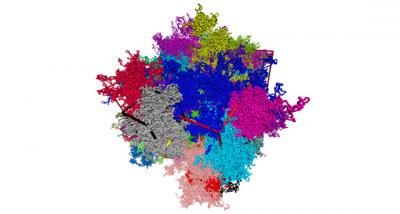It looks like rubber but isn't
What goes on in a concentrated solution of circular polymers?
Advertisement
The experimental and numerical study of the behaviour of polymers in concentrated solutions is a line of research that is still highly active. In the past, it enabled us to understand why materials like rubber have certain elastic properties. A distinctive feature of these systems is that the long "chained" molecules composing them tend to penetrate each other and interweave at their ends forming very durable bonds that make them always return to their initial conformation whenever they are "stretched".

This is a solution of ring polymers (each color corresponds to one polymer).
SISSA
The behaviour of dense solutions of "ring" polymers, i.e., polymers that form closed loops like rings and have no free ends, is very different. Angelo Rosa, a theoretical physicist from the International School for Advanced Studies (SISSA) in Trieste, and Ralf Everaers from the École Normale Supérieure de Lyon devised a highly efficient numerical method to study these materials, a method which they intend to apply to biology in the future.
"Ring polymers – by construction – don't have free ends and so when in a solution they cannot interweave with each other and form bonds as the more common linear polymers do", explains Rosa. "This causes them to behave very differently from linear polymers. So we wanted to understand the physics of these peculiar solutions and we constructed some models of ring polymers that allowed us to predict their behaviour. We then compared the models we created with other earlier simulations conducted with different methods, and found that they confirmed our findings".
"The really interesting thing about our study is that it considerably reduces analysis time, which means the method is highly efficient", the researcher adds. "We found that compared to dense solutions of linear polymers, which form the base of the more common visco-elastic materials such as rubber, these materials are much more fragile because a ring polymer interweaves very little with the others and remains "topologically" always confined within a restricted region".
Rosa and Everaers point out that they will now continue to develop their research in the field of biology. "We think that our models of ring polymers are useful to understand chromosomes dissolved in the cell nucleus", says Rosa. "Even though it isn't a circular polymer, a chromosome behaves in a very similar manner, in that it remains topologically isolated from the other chromosomes dissolved in the cytoplasm for a long time".

























































